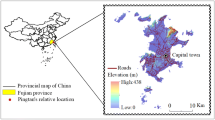Abstract
How land-cover has been changed by human use over the last 300 years is one of the five overarching questions guiding the Land-use/Cover Change (LUCC) Science/Research Plan. China has variety of historical documents providing unique data superiority. So the characteristics of farmaland area in Shandong Province during the Qing Dynasty (1644–1911) are summarized firstly: 1) the rising trend of farmland area was striking; 2) farmland area had remarkable fluctuation; 3) farmland area per capita decreased dramatically; 4) wasteland reclamation index increased rapidly. Then, the driving forces of farmland area change are analyzed. It is concluded that natural and human factors are jointly influential. Among the driving forces, human dimensions are the main factors of farmland area change, which direct the general tendency of the changes mentioned above. And the natural factors influence the stability of farmland area as well. Variation of the natural factors would act as the major contributory factor to farmland area change during years or periods of abrupt climatic changes, or during the intensive occurring periods of natural hazards. Besides, the passive aspects of human factors, such as war chaos also influenced the fluctuation of the farmland area. This research indicates that it is feasible to study the land-use/cover change by Chinese historical literatures, which has huge potential to provide a comprehensive picture of the growing dominance of human land-use and land-cover patterns that can be used in many global change research projects.
Similar content being viewed by others
References
CAO Shu-ji, 2001. Population History of China (Vol. 5, The Qing Dynasty Period) [M]. Shanghai: Fudan University Press, 648, 689. (in Chinese)
CHARLOTTE Wilson, 2002. IGBP Directory 2002/2003 [Z]. Stockholm, Sweden, 32.
Chinese Academy of Agricultural Sciences, Department of Chinese Agricultural Heritage, Nanjing Agronomy College, 1984. Chinese Agronomy History (Preliminary Edition) (The Latter Volume) [M]. Beijing: Science Press, 84–119. (in Chinese)
Department of Material Compilation, Institute of History Research, Chinese Academy of Social Sciences, 1988. Materials of Chinese Historical Natural Disasters and Agricultural Policy of Historical Flourishing Times [M]. Beijing: Agricultural Press, 424–446. (in Chinese)
GE Quan-sheng, WANG Wei-Chyung, 1995. Population pressure, climate change and Taiping Rebellion [J]. Geographical Research, 14(4): 32–41. (in Chinese)
GU Jie-gang, SHI Nian-hai, 1999. Historical of Territorial Evolution of China[M]. Beijing: The Commercial Press, 190, 204. (in Chinese).
LIANG Fang-zhong, 1993. Statistics of Registered Permanent Residence, Farmland, and Land Tax of Chinese Successive Dynasties [M]. Shanghai: Shanghai People’s Press. (in Chinese)
LIANG Jia-mian, 1992. History of Agricultural Science and Technology in China [M]. Beijing: Agriculture Press, 484–492. (in Chinese)
RIK Leemans, KEES Klein Goldewijk, FRANK Oldfield, 2000. BIOME 300: Developing a fasttrack global database of land-cover history [J]. IHDP Update, (3): 6–7.
TAN Qi-xiang, 1982. The Historical Atlas of China (The Yuan Dynasty Period, The Ming Dynasty Period)[M]. Beijing: Cartographic Publishing House. (in Chinese)
TAN Qi-xiang, 1987. The Historical Atlas of China (The Qing Dynasty Period)[M]. Beijing: Cartographic Publishing House, 22–23. (in Chinese)
TIAN Pei-dong, 1998. Study on the farmland amount in the dawn of the Ming Dynasty [J]. Historical Research, (5): 124–134. (in Chinese)
TURNER II B L, DAVID Skole, STEVEN Sanderson et al., 1995. Land-use and land-cover change science/research Plan [A]. IGBP Report No. 35[R], Stockholm, Sweden, 8, 30.
WANG Shao-wu, YE Jin-lin, GONG Dao-yi, 1998. Climate of China during the Little Ice Age [J]. Quartery, (1): 54–64. (in Chinese)
WANG Zheng, ZANG Pi-yuan, ZHOU Qing-bo, 1996. The impacts of climate on the society of China during historical times [J]. Acta Geographica Sinica, 51(4): 329–339. (in Chinese)
XU Ping-hua, 1997. The preliminary study on the relation between population and the periodic fluctuation of Chinese feudal society[J]. Chinese History Research, (3): 13–21. (in Chinese)
ZHANG Gui-qin, 1997. The Preliminary Research on the Cold/Warm Changes in Shandong Province from 1470 to 1990 [D]. Academic thesis for application of the Master degree, Shandong Normal University. (in Chinese)
ZHANG Jia-cheng, 1988. The Reconstruction of Climate in China for Historical Times [M]. Beijing: Science Press, 146.
ZHANG Pi-yuan, GE Quan-sheng, ZHENG Jing-yun, 1999. Research activities in Task 2 (proxy data) at IG / CAS (A). In: TAO Shi-yan, MICHAEL Riches, CHEN Pan-qin et al. (eds.) Greenhouse Effect and Climate Change[C]. Beijing: China Ocean Press, 143–147.
ZHANG Xue-qin, LI Ai-zhen, 1999. Laws of droughtwaterlogging during 1470–1990 in Shandong Province[J]. Journal of Natural Disasters, 8(2): 125–131. (in Chinese)
ZHANG Yan, 1998. Brief History of Economy in the Qing Dynasty[M]. Zhengzhou: Zhongzhou Ancient Books Publishing House, 478–483. (in Chinese)
ZHAO Song-qiao, 1998. Human resources and population problems in China[A]. In: ZHAO Song-qiao (ed.). Selected Works of Zhao Songqiao [C]. Beijing: Science Press, 119.
ZOU Yi-lin, 1995. The transformation of the agricultural and transitional belt in the North China and the cold/warm climatic change during the Ming and Qing dynasties [J]. Journal of the Fudan University (Social Science Version), (1): 25–33. (in Chinese)
Author information
Authors and Affiliations
Additional information
Foundation item: Under the auspices of the National Natural Science Foundation of China (No.40201005), and the Knowledge Innovation Project of Chinese Academy of Sciences (KZCX3-SW-321, KZCX2-314, KZCX1-SW-321-4)
Biography: ZHANG Xue-qin (1971–), female, a native of Shandong Province, associate professor, Ph. D., specialized in historical environmental changes and global changes. E-mail: zhangxq@igsnrr.ac.cn
Rights and permissions
About this article
Cite this article
Zhang, Xq., Ge, Qs. & Zheng, Jy. Analysis of driving forces on the change of historical farmland use in Shandong province during the Qing Dynasty (1644–1911). Chin. Geograph.Sc. 13, 207–215 (2003). https://doi.org/10.1007/s11769-003-0018-3
Received:
Issue Date:
DOI: https://doi.org/10.1007/s11769-003-0018-3




